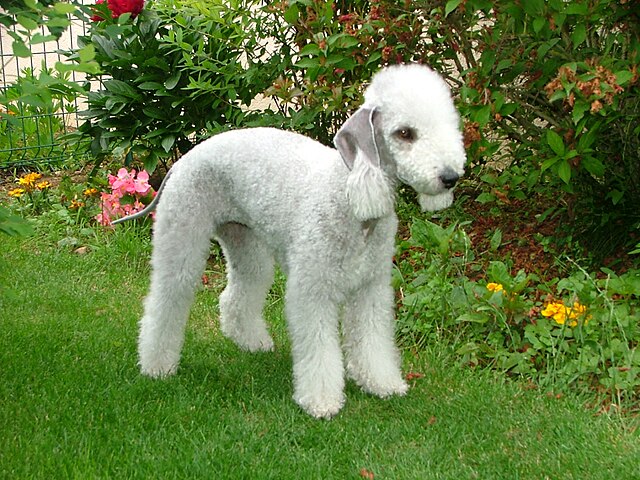


The Bedlington Terrier is a small to medium-sized breed known for its distinctive lamb-like appearance, with a soft, curly coat and a tufted head. Despite their somewhat delicate look, Bedlington Terriers are energetic, agile, and confident dogs with a keen hunting instinct. They were originally bred for hunting small game, but today they make affectionate and lively companions. Their unique coat requires regular grooming, and their spirited personality makes them well-suited for active individuals or families.
The Bedlington Terrier originates from the town of Bedlington in Northumberland, England, where it was initially bred in the 18th century. It was developed to hunt small game like rats, rabbits, and foxes, using its speed, agility, and tenacity. The breed is believed to be a cross between the now-extinct English Rough Terrier and other terriers. Over time, the Bedlington Terrier became popular as a companion dog, especially due to its gentle temperament and distinctive appearance. It was first recognized by the Kennel Club in the UK in 1870 and continues to be cherished as a unique and charming dog breed today.
The Bedlington Terrier has a distinctive appearance that sets it apart from other breeds. It is a small, graceful dog with a narrow, arched back and a head shaped like a lamb’s, complete with a soft, curly coat that adds to its lamb-like appearance. They typically stand 15 to 17 inches tall and weigh around 17 to 23 pounds. Their coat is usually a blend of blue, liver, or sandy colors, often with darker markings. The Bedlington Terrier’s coat requires regular grooming to maintain its texture and prevent matting. The breed’s eyes are dark and almond-shaped, and their ears are triangular, hanging close to the head. Their tail is long and tapers to a point, carried low when relaxed but held higher when active.
Bedlington Terriers are known for their affectionate, friendly, and sometimes mischievous personalities. They are highly intelligent and often described as "big dogs in a small body," due to their confident and bold nature. They are generally good with children and can make excellent family pets, though their terrier instincts may lead them to be somewhat independent or headstrong. They can be wary of strangers but are typically not aggressive. Early socialization and consistent training are important to ensure they are well-behaved around other animals and new situations. They are loyal and protective of their family and can make excellent companions for those who appreciate their spirited, yet affectionate nature.
The Bedlington Terrier is an active and energetic breed that requires regular exercise to stay healthy and happy. They enjoy daily walks, playtime, and even more vigorous activities like running or playing fetch. Their hunting background gives them a strong prey drive, so it’s important to supervise them when off-leash, as they may chase small animals. In addition to physical exercise, they also benefit from mental stimulation, such as puzzle toys or training exercises, to keep their minds engaged. While they enjoy being active, they are also content to relax with their family after a good workout. They are best suited for homes where they can get plenty of daily exercise and interaction.
Training the Bedlington Terrier requires patience and consistency, as they are an intelligent but independent breed. They can be somewhat stubborn and may not always be eager to please, so it's important to use positive reinforcement methods, such as treats and praise, to encourage good behavior. Early socialization is crucial for ensuring they grow up to be well-adjusted dogs. Exposing them to various people, dogs, and environments from a young age will help them become more comfortable with new situations. While they may have a strong prey drive, with proper training, Bedlington Terriers can coexist peacefully with other pets. Consistent, gentle training methods work best, as harsh methods can cause them to become more independent and harder to manage.
Bedlington Terriers are generally healthy dogs, with a lifespan of 12 to 16 years. However, like many purebred dogs, they are prone to certain health conditions. Some of the most common issues in the breed include hip dysplasia, progressive retinal atrophy (PRA), and copper toxicosis (a condition that affects the liver). Regular veterinary check-ups are essential for monitoring their health, especially as they age. Their unique coat requires frequent grooming to maintain its quality and prevent matting. Brushing several times a week is recommended, and occasional professional grooming may be needed to keep their coat looking its best. Additionally, their ears should be checked regularly for signs of infection, and their teeth should be brushed regularly to prevent dental issues.
The average lifespan of a Bedlington Terrier is between 12 and 16 years. With proper care, including regular veterinary visits, a balanced diet, and appropriate exercise, they can live a long and healthy life. It's important to monitor their health for breed-specific conditions and address any concerns promptly. Their small size and active lifestyle contribute to their overall good health, but regular attention to their grooming and general well-being will ensure they remain happy throughout their life.
© copyright Dog Compendium 2024 - 2025